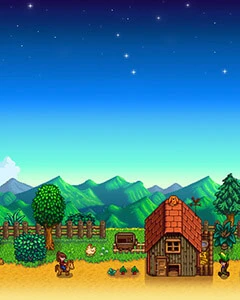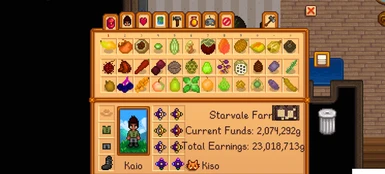About this mod
Adds a large number of unusual field crops and trees to the game.
File is now outdated and replaced by https://www.nexusmods.com/stardewvalley/mods/22490
- Requirements
- Permissions and credits
-
Translations
- Mandarin
- Changelogs
- Donations
IMPORTANT: TREES ARE A WIP. The end product is complete, but most of the trees look identical, so it would be wise to have a mod that shows you which tree is which. I'm working on a naturalistic look for them, which is taking a ton of time for each tree, so I will be posting updates over time as each batch is finished (I won't do an update for an individual tree, probably more like 5-10 at a time). All of the actual end products are complete, so your harvest will look lovely. Field crops are not a WiP, they are done. I recommend using a modded farm with room for a lot of trees.
Also underway:
- a recipe mod which uses all of the produce, also incorporating my previous mods
- compatibility with appropriate machines
Do you want to use this mod in your mod in yours? Want to reskin anything to match your personal vision, or post a translation? Feel free! All I ask is that you give me full credit for the original and link back to this mod.
To install, simply download, unzip, and drop into your mods folder. If you are putting this into an existing game, I recommend going into the manifest of the file and changing the name by adding a z or zz at the beginning, from "Bonster..." to "zBonster...". JSON uploads files and assigns them object numbers alphabetically, and just dropping this into a game you're already playing may result in some very strange things happening to your items that you have stored.
Field crops:
Arctic Raspberry: Fairly small but very flavorful, the plants grow only a few inches high.
Artichoke Thistle: also known as cardoon, this artichoke cousin features edible stems
Camas: a native American bulb, also called quamash, which resembles the taste and texture of sweet potato when cooked
Chinese Artichoke: not an artichoke but a member of the mint family, these peculiar roots taste like their namesake
Four Corners Potato: named after the Four Corners region of the SW United States, this potato cousin is small but very nutritious
Garnet Sweet Potato: my personal favorite, an orange sweet potato with dark orange flesh
Hardy Kiwi: grape-sized, smooth-skinned fruit taste like mild, sweet kiwi, and are eaten without peeling
Hopniss: another native US root, also called the American groundnut, this member of the bean family also has edible beans and flowers
Incan Ground Cherry: Also called the Incan golden berry, this physalis tastes like tangerine mixed with pineapple
Julep Mint: A sweet mint lacking much of the bitterness in more common mint varieties
Kutjera: Also called desert raisin, this is a fine example of Australian bush tucker, and is becoming increasingly popular as a flavoring ingredient
Long Island Cheese Pumpkin: resembling a wheel of cheese, this pumpkin has flavorful orange flesh well suited for both sweet and savory dishes
Mung Bean: A staple ingredient in many Asian cuisines, this is the source of bean sprouts
Oca: A root of many colors, this Andean tuber is crisp, mildly lemony, and can be eaten both fresh and raw
Oysternut: A large squash, the kweme is primarily grown for its large seeds, which resemble oysters. The seeds are pressed for high quality oil as well as eaten as a vegetable rich in protein and healthy fats.
Red Carrot: A brightly colored carrot full of carroty goodness and beta-carotenes
Sacred Water Lotus: This beautiful lotus has a large root and thick stems, both of which are eaten as vegetables
Salal: A native American berry, the salal have an earthy blueberry flavor, but can be a little dry. They are often eaten mixed with something juicy, and may feature in akutaq, a native ice cream made of fish, fat and berries
Samphire: a succulent found in waterlogged areas like marshes and beaches, it has a crisp, salty flavor
Sea Buckthorn: Highly nutritious but quite sour, this nutritious berry is usually mixed with something sweet
Skirret: Very popular at one time, and prominent in cookbooks from 1400-1800, this sweet, thin root lost favor but not flavor
Sweet Basil: A versatile herb without the sharpness that accompanies more potent basil varieties
Sweet Granadilla: a close cousin to the passion fruit, both in the passiflora genus, the granadilla is much sweet and much less acidic than its relative
Tiger Nut: Not a nut at all, but a tuberous rhizome of the sedge plant. These small vegetables have a chewy texture and a flavor that resembles coconut
Tomatillo: Another physalis, this fruit resembles the green tomato in taste, with a fruity overtone
Ube: This purple yam adds a very colorful, sweet punch to recipes
Wild Rice: Not actually a rice, these grass seeds grow on the margins of lakes, and are often harvested in the wild from small boats
Yacon: A South American tuber is a member of the daisy family, and tastes somewhat like a floral, resinous jicama
Yellow Onion: It's an onion
Trees:
Abiu: The sweet, caramel-custard flesh of this fruit has a pale, translucent appearance, and is typically eaten fresh or used to flavor ice cream or other mild confection.
Acerola (Barbados Cherry): The pleasant tasting berries are sweet-tart, fragrant and very high in vitamin C.
Achachairú: Dubbed the Achacha by marketers in Australia, the achachairú is a relative of the mangosteen, with a sweet and moderately tart flavor. It is becoming increasingly popular.
Alphonso Mango: A favorite variety of mango, the Alphonso is rich, creamy and almost fiberless, with a sweet, rich flavor.
American Persimmon: Often gathered in the wild, the American persimmon has a rich, sweet nutty flavor, and is beloved by wildlife and humans alike once ripe enough to lose its astringency. Leaves can be used to make tea, and people make coffee substitute out of the seeds.
Black Madeira Fig: Arguably one of the best figs, with a full, sugary-sweet, syrupy rich berry flavor and deep, port-wine colored flesh.
Black Persimmon: a Texas native, this fruit is tasty and can also be used to make a potent black dye. Probably best not to eat this while dressed in your flower dance outfit.
Black Sapote: The black sapote, a member of the persimmon family, is sometimes called the chocolate pudding fruit, which it resembles in appearance and, some say, taste. To me, it tastes like a delicious honey-date-persimmon blend.
Bunya Bunya: A member of the monkey puzzle family, this conifer bears massive pine cones loaded with large, tasty seeds, with a flavor similar to a chestnut. They have a great deal of cultural importance to many Australian Indigenous groups.
Canistel: The curious eggfruit has a sweet, custardy taste and a texture similar to a hard-boiled egg. Fruit picked while immature may be astringent.
Chaunsa Mango: the king of mangoes is richly flavored, with an aromatic, pleasant and juicy pulp. It is recorded as far back as the 1500s.
Chilean Guava: The uñi combines the flavor of strawberries, kiwi and bubblegum. It is sometimes grown as an ornamental.
Chocolate Persimmon: Sometimes called maru, its Japanese name, this fruit has a rich brown flesh when ripe, which is spicy, firm and very sweet when ripe, and astringent when unripe.
Cupuaçu: Chocolate’s closest kin, the cupuaçu is grown more for its sweet pulp, which combines the taste of chocolate with tropical fruit and melons. Its seeds can be processed to produce its own variety of cocoa, which can be eaten, and cocoa butter, often used in beauty products.
Guanábana: Also called soursop, it isn’t really very sour, resembling a cross between citrus, pineapple, banana and strawberries - but it is a bit more acidic than its cousin, the sweetsop.
Hass Avocado: A very popular avocado that came about by chance in 1926, when the grocer growing it almost cut it down before it could bear fruit.
Honey Fig: Honey describes both the color of the flesh and the sweetness.
Ice Cream Bean: These large bean pods can reach 2 meters long, and eating them involved cracking open the shell and popping out the juicy, chewy, cottony, snowy white and very sweet pulp. The large seeds inside that pulp can be eaten if cooked. The pulp lends a nice flavor to desserts.
Jamaican Cherry: Sometimes called the cotton-candy fruit, this little berry is, no surprise, very sweet!
Kru Banana: a rare New Guinea banana, the Kru is creamy and firm, with a bright, sweet-tart complex citrusy flavor, and orange flesh.
Langsat: A member of the mahogany family, the langsat fruit grows in bunches of 15-25 pieces, with a flavor similar to grapefruit.
Lilly Pilly: A source of Australian bush tucker, the lilly pilly berries are small, varied in color, and have a sweet-tart, musky, fruity and spicy flavor. They are typically used in cooking.
Longan: These lychee and rambutan relatives lack the soft spines of their cousins, but share their tastiness. The longan is tart and gelatinous, with a single black seed in the center.
Loquat: Packed with nutrients, these little fruits were once thought to be close relatives to the medlar, which they don’t really resemble in any way. The small fruit are sweetest when soft, and taste similar to peach and citrus crossed with mango.
Macadamia: The tropical nut is very smooth and mild, but due to its high oil content it is at high risk for going rancid, so eat quickly!
Mahachanok Mango: This Thai mango is very elegant, curved with a shaded skin that sometimes leads to it being called the rainbow mango. It has very sweet, smooth flesh, with a peach-like flavor.
Medlar: Once very popular, and given a number of rude names due to its resemblance to a fundamental body part, the medlar is eaten after bletting, or becoming over-ripe. Ideally, it would be allowed to hang on the tree through the first frost.
Monkey Pot Tree: a Brazil nut relative, the name comes from the belief that monkeys would stick their hands in the palm-shaped pod and not be able to pull it out because they wouldn’t let go of the nuts.
Palmyra Palm: A very versatile tree, the palm has a very tasty jelly-like young seed (sometimes called the ice apple), a sap which makes jaggery, toddy and palm wine, edible nuts, leaves which can be used to make paper, clothing and thatching, and heavy black timber, and more.
Peanut Butter Fruit: So called because of its resemblance in taste to peanut butter and jelly, with a smooth, dense texture.
Pedalai: This relative of the breadfruit and jackfruit is very peculiar looking, with an exterior covered in soft, hair-like protrusions. The delicious, sweet-tart segments inside are creamy and well-flavored, and the seeds are both edible and quite tasty.
Pistachio Nut: Pistachio nuts used to be dyed red - whether that was to hide stains on the shells due to the processing techniques or conceal lower quality nuts is up for debate. Now they’re left natural, and can no longer be used as lipstick in a pinch.
Pitogo Banana: a Filipino banana, which resembles a fig (hence its other name, the fig banana), the pitogo can be eaten in just a few bites. Young bananas are often used as plantains, while mature fruit is softer and creamier, with a bright, sweet and tangy flavor.
Poshte: While these annonas may not be the prettiest when ripe, with the skins blackening, the fruit is very juicy, sweet-tart and meltingly soft.
Pulasan: A cousin to the rambutan and lychee, the pulasan is very sweet and juicy, with an edible seed that tastes similar to almonds
Red Banana: The flesh of this banana is golden-yellow, dense but with a custardy smoothness.
Red Jaboticaba: An interesting example of cauliform growth, where the fruit buds directly off the trunk rather than growing on branches. The flavor is sweet, with a milky creaminess like a blueberry yogurt
Red Walnut: Larger and sweeter than the more common English walnut, the skin is bright red while the meat is light cream.
Rollinia: Often described as the best of the annonas, the rollinia is also called the biribá, lemon meringue pie fruit, aratiku or wild sugar apple. The pulp is very soft and sweet-tart.
Ruby Guava: While green on the outside, this guava is bright red inside, with a crisp, tart and juicy pulp suited for eating fresh and cooking.
Rumberry: Grown in the caribbean, the rumberry is so named because it makes an exquisite liqueur, often combined with rum, raw sugar and spices. It is also eaten fresh and cooked.
Salak Palm: also called snakefruit, due to its scale-like skin, the salak palm is widely cultivated in Indonesia. The salak gula pasir is the sweetest, most fine-grained variety, and the most expensive
Sapodilla: A tree of many names, including chikoo, mispel, dilly, naseberry, and sapoti, the exceptionally sweet, malty fruit is very popular in many tropical regions around the world
Saskatoon: raised in the far north, the Saskatoon is not only fun to say, but the sweet berries are also good to eat. Also called serviceberry, shadbush or chuckley pear.
Shipova: a cross between the pear and the common whitebeam, first bred in the 1700s, the small fruit have flesh similar in taste to the Asian pear and a rose-like scent
Sunrise Papaya: One of the world’s most popular papayas, the large fruit have a distinctive golden-red interior
Tiger Fig: a striped fig with a raspberry interior, and a moderate fig flavor
Wattleseed: The seed of an acacia tree from Australia, which combines flavors of coffee, cocoa and hazelnut, this bush tucker is becoming trendy
White Sapote: A creamy, sweet fruit, a bit like a tropical fruit pudding on a tree
Ya Li Pear: A sweet, crisp Asian pear which is shaped like a European pear
Yellow Pitahaya: a member of the dragon fruit family, often considered the best quality but, unfortunately, not the best keeper













